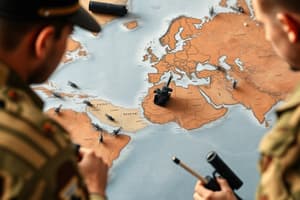Podcast
Questions and Answers
What does FM 100-14 explain?
What does FM 100-14 explain?
- Emergency response protocols
- Principles, procedures, and responsibilities to apply risk management (correct)
- Risk Management Process
- Combat strategies
What is the process of Risk Management?
What is the process of Risk Management?
Identifying, assessing, and controlling risks arising from operational factors.
Which of the following assists the commander/leader in conserving lives/resources?
Which of the following assists the commander/leader in conserving lives/resources?
- Implementing risky courses of action
- Overlooking risks
- Identifying effective control measures (correct)
- Ignoring standard drills
Risk Management applies to all levels of Army operations.
Risk Management applies to all levels of Army operations.
What is NOT a principle of Risk Management?
What is NOT a principle of Risk Management?
Risk Management requires a GO/NO GO decision.
Risk Management requires a GO/NO GO decision.
What are the five steps of Risk Management?
What are the five steps of Risk Management?
What are the two types of risks identified in Risk Management?
What are the two types of risks identified in Risk Management?
What does Tactical Risk refer to?
What does Tactical Risk refer to?
How does Accident Risk differ from Tactical Risk?
How does Accident Risk differ from Tactical Risk?
What factors are considered in identifying hazards?
What factors are considered in identifying hazards?
Which of the following is a term used in Risk Management?
Which of the following is a term used in Risk Management?
The chance of hazards or bad consequences is known as _____.
The chance of hazards or bad consequences is known as _____.
What does Severity refer to in Risk Management?
What does Severity refer to in Risk Management?
Exposure is the frequency and duration soldiers, equipment, and missions are subject to a hazard.
Exposure is the frequency and duration soldiers, equipment, and missions are subject to a hazard.
What are the five key hazard conditions?
What are the five key hazard conditions?
What actions are described as Controls in Risk Management?
What actions are described as Controls in Risk Management?
Flashcards are hidden until you start studying
Study Notes
Risk Management Principles
- FM 100-14 emphasizes the importance of risk management for conserving combat power and resources.
- Risk management is the systematic process of identifying, assessing, and controlling risks related to operational factors while balancing risk costs with mission benefits.
Goals and Benefits of Risk Management
- Aims to conserve lives and resources while avoiding unnecessary risks.
- Supports informed decision-making to implement a Course of Action (COA).
- Identifies practical control measures when specific guidelines are lacking.
Fundamental Concepts
- Risk management is applicable at all levels, involving leaders and soldiers across various Army operations.
- It is integral to mission planning, execution, and preparation, ensuring risks are assessed at appropriate levels within the command structure.
Limitations of Risk Management
- Does not inhibit commanders or leaders' flexibility or initiative.
- Does not eliminate risks or adopt a zero defects mentality.
- Does not necessitate a GO/NO GO decision or sanction legal violations.
- Does not eliminate the need for standardized drills and procedures.
Risk Management Process Overview
- Focuses on identifying and controlling hazards to optimize combat resources.
- Involves five critical steps: identifying hazards; assessing risks; developing and implementing controls; and continuous supervision and evaluation.
Types of Risks
- Distinguishes between Tactical Risk (related to enemy presence) and Accident Risk (all other operational risks, including hazards to personnel, civilians, and the environment).
Steps in Risk Management
- Steps 1 and 2 prioritize risk assessment to bolster situational awareness: identifying hazards and evaluating their direct impacts on missions.
- Steps 3 to 5 emphasize the necessity of follow-through: balancing risks, continuous assessment during execution, and evaluating the effectiveness of implemented controls.
Hazard Identification
- Involves recognizing hazards to personnel, property, and mission effectiveness while accounting for current and future operational conditions.
- Requires consideration of METT-TC (Mission, Enemy, Terrain, Troops, Time, and civilian considerations).
Conditions Affecting Risk
- Five key hazard conditions influence risk management effectiveness: complexity of mission; terrain/environment; available equipment; experience; morale; and training.
Risk Management Terminology
- Key terms to understand include Hazard (potential condition for harm), Probability (likelihood of occurrence), Severity (expected impact), Exposure (frequency and duration of hazard exposure), and Controls (actions to mitigate risk).
Understanding Risks and Their Impact
- Risks represent the chance of negative outcomes due to hazards.
- Probability categories: Frequent (often), Likely (several times), Occasional (sporadic), Seldom (rarely), Unlikely (not expected).
- Severity refers to the expected consequence of an event, while exposure pertains to how often and how long soldiers, equipment, and missions face a hazard.
Studying That Suits You
Use AI to generate personalized quizzes and flashcards to suit your learning preferences.




